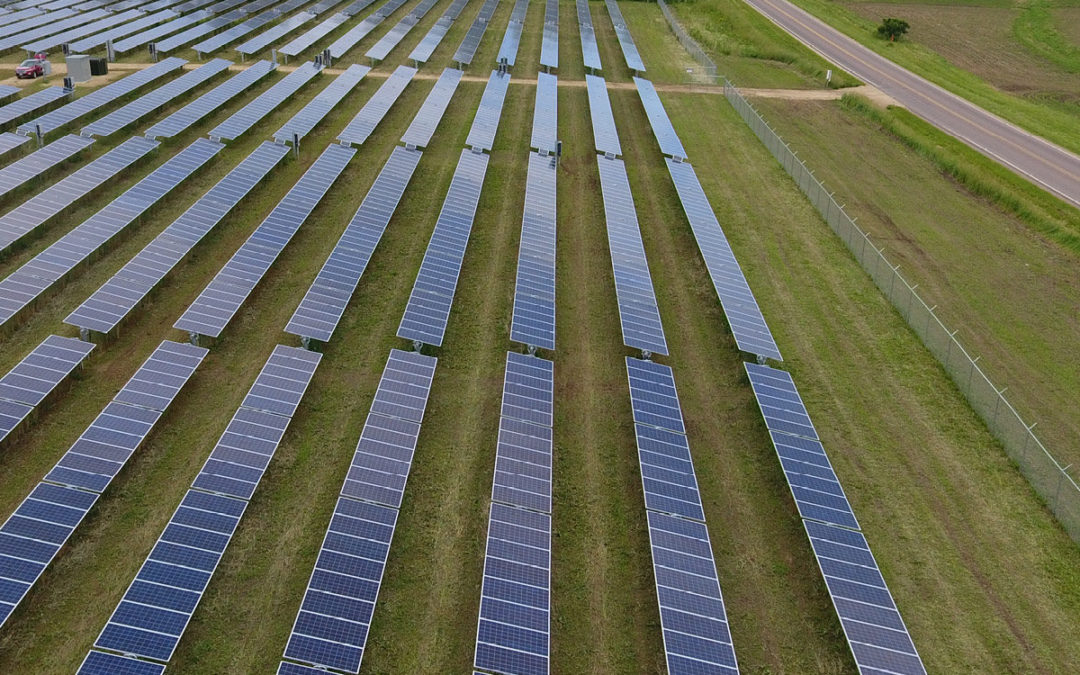
by Tyler Huebner | Oct 17, 2018 | Jobs, Solar, Utilities, Utility Scale
In recent years, private companies and our state’s power providers have been building “solar farms” in Wisconsin. These are large-scale solar energy facilities providing homegrown, healthy, and smart energy to Wisconsin citizens.
These new solar farms provide homegrown energy, making power right here in Wisconsin. Solar farms provide an opportunity to boost local economies and create jobs. Already Wisconsin’s renewable energy industry employs more than 75,000 workers – more than all the waiters, waitresses, computer programmers, lawyers and web developers in the state combined. This number stands to grow substantially as we explore more renewable energy development.
Solar farms are healthy – they put out no emissions or pollution, and they use no water from the ground or surface. Many solar farms implement native meadow vegetation that prevents soil erosion, provides weed control, and produces a natural (and healthy) habitat for pollinators and wildlife.
Solar farms are smart for Wisconsin, because they are cost-competitive with traditional ways of making electricity. The cost of developing solar power projects has dropped by over 75% in the past decade. And solar power technology has improved, so that more of the sunlight is directly converted to power.
As some of these solar projects are getting underway and Wisconsin’s energy landscape is changing, RENEW Wisconsin is here to provide information and answer questions.
We’ve made a fact sheet showing all the potential solar and wind development that is being explored in the state. It also shows what our power companies are planning to do to shift towards homegrown and clean, renewable energy including solar and wind.
Beyond that, we’ve fielded dozens of questions and prepared straightforward answers that are easy to understand. In addition to having this online tool, we have 2-page and longer version of these “Frequently Asked Questions” that citizens can use.
Solar farms: homegrown, healthy, and smart for Wisconsin. Learn more on our new Solar Farms web page!
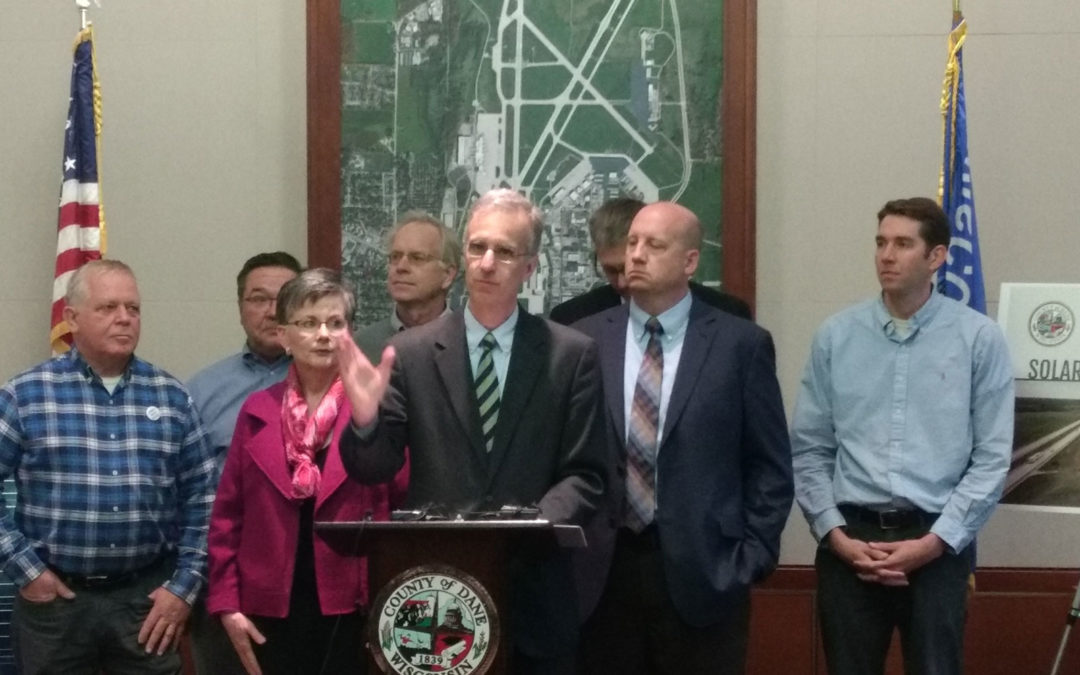
by Michael Vickerman | Oct 11, 2018 | Solar, Utilities
Dane County and Madison Gas and Electric (MGE) are joining forces to construct a solar power plant on County-owned land that will supply clean electricity for one customer only: Dane County. The solar array, expected to total eight megawatts of capacity, will be situated on a 41-acre parcel at the north end of Dane County Regional Airport. MGE will own the array, which will be interconnected directly to the utility’s distribution system nearby.
This project invites superlatives. When completed, it will be the largest solar power plant in Dane County, more than three times as large as Epic Systems’ 2.2 MW installation serving its Verona headquarters, and four times as large as Madison College’s 1.8 MW rooftop array at its Truax campus, which is expected to start generating electricity in November.
Thanks to its Renewable Energy Rider service, MGE has the capability of supplying commercial customers to clean electricity generated from new, offsite solar installations. Through this service, customers like Dane County can lock in a dedicated source of solar at a fixed price for up to 20 years. The cost of building a Renewable Energy Rider project would be borne exclusively by the customer or customers purchasing the electricity. Other nonparticipating customers would be unaffected by the transaction.
In this case, MGE will recover the full cost of building the airport installation from Dane County’s energy purchases. The county has a goal to source 100% of the electricity it consumes from renewable resources. The output from the airport project should total about 25% of the County’s annual electrical usage.
Later this fall, MGE will select a general contractor to design and build this installation. The utility will also file an application for permission to supply Dane County with the project’s output. The Public Service Commission will review the terms of the agreement to ensure that the airport array is cost-neutral from the standpoint of the utility’s other customers.
Dane County and MGE jointly unveiled its partnership at an October 1st press conference at the airport. The announcement also coincided with the unveiling of the County Executive’s proposed budget for 2019, containing a number of provisions to advance the County’s development and use of renewable energy. One of them involves Lake Farm Park, home of Lussier Family Heritage Center and numerous campsites. The proposed budget allocates $435,000 to build enough solar capacity to supply 100% of the electricity and hot water used at the park.
“Dane County is a nationally-recognized leader in renewable energy adoption and innovation. From the hardest-working landfill in the state, to what will be one of the largest solar farms in the state, I’m proud of the progress we’ve made,” said Dane County Executive Joe Parisi. “This historic solar farm will help increase local clean energy jobs, reduce carbon emissions, and reduce the tax burden on Dane County residents through lower energy bills.”
“MGE welcomes the opportunity to partner at the County’s request on this solar project and supports its efforts to achieve 100% renewable energy for its facilities,” said MGE Chairman, President and CEO Jeff Keebler.
If approved, construction of the project is expected to begin in 2019. For more information on the project see: https://www.countyofdane.com/press/details.aspx?id=4370
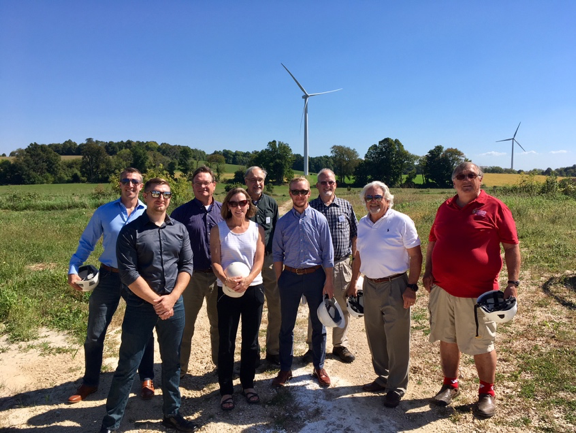
by Jim Boullion | Oct 2, 2018 | Advocacy, Biogas, Electric Vehicles, Events, Jobs, Policy, RENEW Wisconsin, Renewables, Solar, Utilities, Wind
September was a busy month for me and RENEW Wisconsin. I attended more than 30 meetings, seminars and site visits all over the state. Many of them involved learning about Wisconsin’s exciting and fast growing renewable energy industry and building relationships with the talented people who help make it go. There were also numerous meetings with state and local policy makers as well as the leadership of many influential trade associations, unions and advocacy groups. Working together, we are starting to develop ideas for the 2019-20 legislative session that will help advance the use of clean, renewable energy that will create jobs, economic growth and save money for everyone!
Customers First! Power Lunch – Go Electric!
September got off with a “high voltage” start at the Customers First! Coalition Power Lunch, with the theme of “Go Electric”. Over 120 attendees learned about the latest developments and benefits of electric vehicles and “efficient electrification” – replacing direct fossil fuel use with electricity in a way that reduces overall emissions and energy costs. Efficient Electrification holds significant potential benefits for Wisconsin customers, utilities, and environmental advocates alike. PSC Chairman Lon Roberts gave the opening keynote speech and several panels with utility executives and state legislators Mark Spreitzer (D-Beloit) and Mike Kuglitsch (R-New Berlin) dove deeper into the technical and policy issues that will need to be addressed to keep up with these fast-growing trends. The program was interesting enough that WisconsinEye, the not-for-profit State Capitol broadcast network, recorded the event.
Emmi Roth Solar Panels
On September 11th I joined State Representative Travis Tranel at the Emmi Roth Cheese plant in Platteville to cut the ribbon on their new 1,600 panel solar system. The system will provide 15% of their electric use. “There are many companies trying to live up to sustainability goals,” said Jim Pullen, General Manager at Eagle Point Solar, who installed the system. “Emmi Roth is part of a group that actually makes these goals a reality and invests in the environment.” The company also recently invested in a new anaerobic digester at the same location in Platteville, Wisconsin, in an effort to lower operational costs and remain environmentally responsible for the waste being produced during their cheesemaking operations. According to Tim Omer, president and managing director at Emmi Roth, “We have a very strong commitment to sustainability. We want to have the lowest possible carbon footprint we could have in the industry.”
Butler Ridge Wind Farm
On September 17th, Pauline Meyer and Nic Cravillion, policy staff from Congressman Mike Gallagher’s office, and Dodge County Board member Russ Kattke joined me at a tour of the Butler Ridge Wind Energy Center in Dodge County. This was a behind the scenes tour of one of Wisconsin’s premier wind farms and was hosted by NextEra Energy Resources. Butler Ridge’s 36 turbines generate 54-megawatts of clean, renewable energy to power more than 13,500 homes. Wisconsin based Faith Technologies, who installed the ground grid and in-tower wiring, and The Boldt Construction Company were two of the prime contractors on the project.
Conservative Energy Forum Summit on “Advancing Wisconsin’s Clean Energy Economy” and Clean Energy Week Proclamation by Governor Walker
On Thursday, September 27th the Wisconsin Conservative Energy Forum hosted a summit onclean energy developments in Wisconsin. PSC Commissioner Lon Roberts opened the meeting discussing the bright future of renewable energy. Several guest panels discussed Utility Scale Clean Energy – A Turning Point for Wisconsin Utilities, and Decentralizing Energy & Encouraging Private Sector Investment. Lt. Governor Rebecca Kleefisch also spoke about the great things happening for clean energy in Wisconsin and how renewable energy fits so well into a conservative political viewpoint. At the end of her talk, Kleefisch presented a proclamation from Governor Scott Walker designating September 24th to September 28th as Clean Energy Week in Wisconsin. This echoed the clean energy week activities around the country.
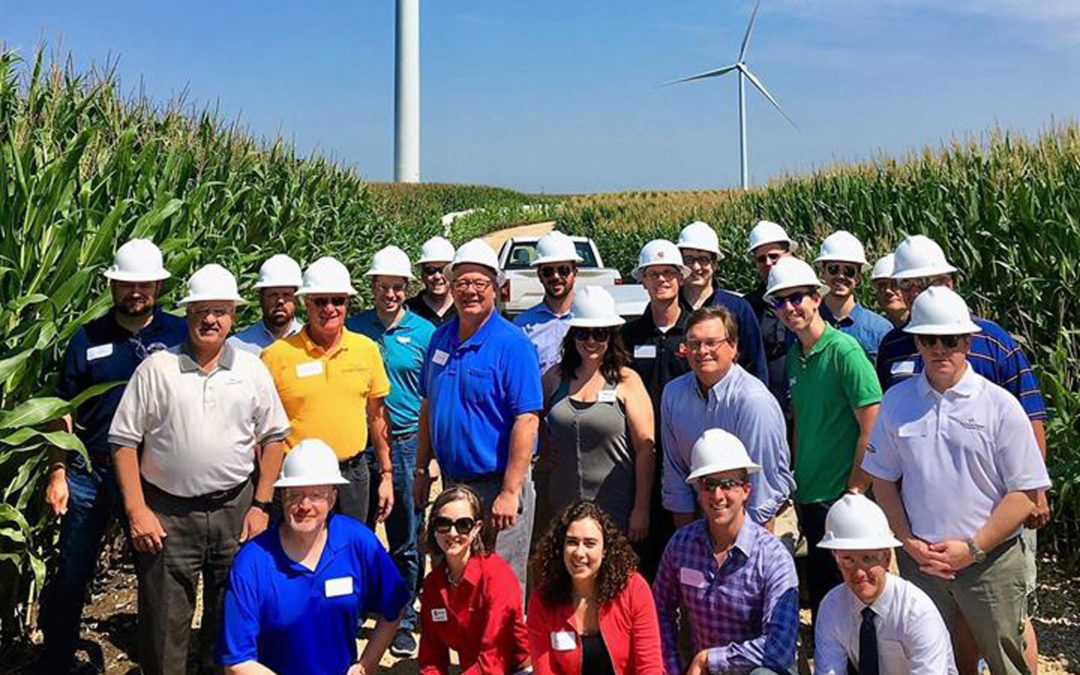
by Jim Boullion | Sep 4, 2018 | Biogas, Events, RENEW Wisconsin, Renewables, Solar, Utilities, Wind
Quilt Block Wind Farm
On August 9th, Vanessa Tutos, Director of Government Affairs for EDP Renewables hosted me and a large group of legislators, legislative staff and other interested people on a tour of their Quilt Block Wind Farm near Darlington, Wisconsin.
During a pre-tour briefing, Vanessa and the EDP Renewable staff gave an overview of the facility and how it works. Darlington Mayor Dave Breunig also participated in the briefing, explaining the many benefits that the Quilt Block facility brings to the local communities, including not only the town and county tax revenues, but the good paying jobs at Quilt Block and the many community businesses that benefit such as restaurants, hotels and other shops.
In attendance were State Senator Howard Marklein and Rep. Todd Novak. Legislative staff: Garrett Huffman, Rep. Kuglitsch (Assembly Utilities Committee Chair); Kyle Koenen and JJ Sherman, Sen. Kapenga staff; Brian Radday, Sen. LeMahieu staff (Senate Utilities Committee Chair); Evan Miller, Sen. Cowles staff (Senate Energy Committee Chair); Dave Breunig, Mayor of Darlington; Alex Ignatowski, Wis. Public Service Commission; Ryan Owens, Tommy Thompson Center on Public Leadership – UW Madison; Jon Hochkammer, Wisconsin Counties Association; Rob Richard, Wisconsin Farm Bureau; Tim Hoven, EDPR
School Sisters of St. Francis
On Tuesday, August 22nd, the Wisconsin Association of Energy Engineers invited me and Jane McCurry of the RENEW Wisconsin staff to tour something old and something new, all in one location, the School Sisters of St. Francis campus in Milwaukee. The Sisters recently installed a 375-kW solar array with 1,086 panels on several of their buildings.
Sister Carol Rigali, Coordinator of the province leadership team, specifically asked that the panels be made in the USA. As Mike Cornell of Arch Electric explained, they acquired the panels from Seraphim Solar USA, from Jackson, Mississippi. Sister Carol said that St. Francis expects to save $1.5 million in energy costs over the life of the system, but that was only one reason they did the project.
She noted that in his 2015 encyclical Laudato Si, Pope Francis specifically mentioned installing solar panels as one way to care for creation. “This solar energy project will enable us to lessen our energy consumption and to invest in our care of the earth.” The chapel was finished in 1914 but looks as amazing as the day it was built. The art and architecture inside compare to some of the best churches anywhere in the world. Now they have a state-of-the-art solar generation system that will help them achieve their mission now and into the future. Preserving the past by embracing the future! Nicely done Sisters!
Wisconsin Agriculture Coalition
On Monday, August 27, I was joined by RENEW Wisconsin’s Executive Director Tyler Huebner, Scott Smith from Madison Gas & Electric and Neil Palmer from Invenergy to give a briefing to the Wisconsin Agriculture Coalition about the latest developments in renewable energy and how it may affect their members. The Agriculture Coalition is a group of association executives and government affairs staff who meet regularly to discuss legislative and regulatory issues in which they have a common interest.
I opened the meeting by discussing the changing economics and politics of renewable energy and let them know that they are going to be seeing a lot of activity in Wisconsin. Tyler then gave an overview of renewables in Wisconsin that will especially impact farms and agriculture related businesses such as solar and wind farms and biogas generation. Scott gave the utility perspective on why they are all adding large scale renewables to their portfolio and the benefits that they see for their customers. In particular, he noted that the driving force was the impressive price drop of over 75% for solar power in the last 10 years.
Finally, Neil spent some time explaining how Invenergy goes about developing a utility scale solar project, from identifying good locations with access to substations and landowners with enough flat, open land who are interested in leasing their property, to the steps and timing of the regulatory process. We also had a good discussion about the “frequently asked questions” that they may be hearing from their members and how to answer them. In summary, everyone in attendance received a good, general understanding of the amazing changes that are happening in the renewable industry and that RENEW Wisconsin is their source for reliable, fact-based information!
Members of the Ag Coalition include:
- Wisconsin Farm Bureau Federation
- Wisconsin Farmers Union
- Dairy Business Association
- Wisconsin Cheese Makers Association
- Midwest Food Products Association
- Wisconsin Agri-Business Association
- Wisconsin Association of Professional Agricultural Consultants
- Wisconsin Cattlemen Association
- Wisconsin Pork Association
- Wisconsin Soybean Association
- Wisconsin Potato and Vegetable Growers Association
- Wisconsin Corn Growers Association
- The Cooperative Network Associations
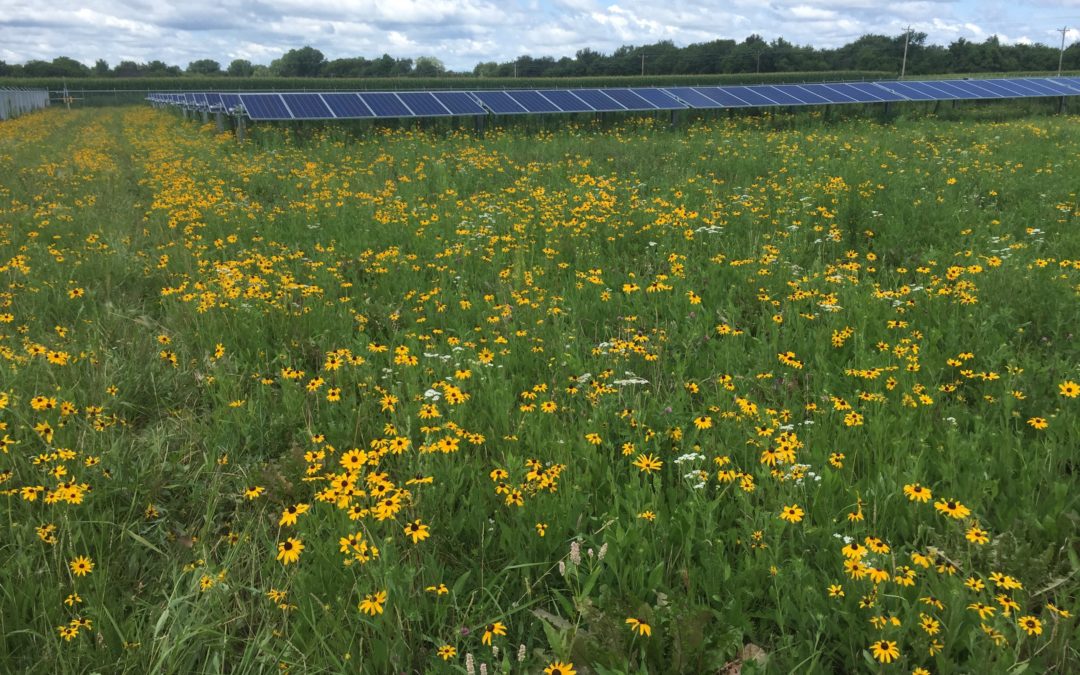
by Tyler Huebner | May 31, 2018 | Solar, Utilities
Today, Wisconsin Public Service (WPS) and Madison Gas & Electric (MGE) announced they propose to acquire 300 megawatts (MW) of solar power at two different locations in Wisconsin. In addition, the developers of the two facilities filed their formal proposals with the state’s Public Service Commission.
The projects are as follows:
• Badger Hollow Solar Farm in Iowa County in southwest Wisconsin near the villages of Montfort and Cobb. This project may be as large as 300 MW, of which 150 MW will be acquired by WPS and MGE.
• Two Creeks Solar in Manitowoc and Kewaunee Counties in the Town of Two Creeks and the City of Two Rivers. This project will be 150 MW.
WPS will own 100 MW shares of each project (200 MW total) while MGE will own 50 MW of each project (100 MW total). The electricity production from the utility-owned facilities announced today would equal the annual electric usage of approximately 67,000 Wisconsin homes, and will provide approximately 1% of Wisconsin’s annual electricity production. This amount of solar will more than triple the solar power capacity currently online in Wisconsin.
RENEW Wisconsin Executive Director Tyler Huebner said: “This is a landmark day for solar power and renewable energy in Wisconsin. Homeowners, businesses, and nonprofits have been enjoying the benefits of solar energy for years. We are excited that our power companies and these solar developers are making investments at scale to power Wisconsin with more home-grown clean and renewable energy.”
Read more:
Wisconsin State Journal
Journal Sentinal
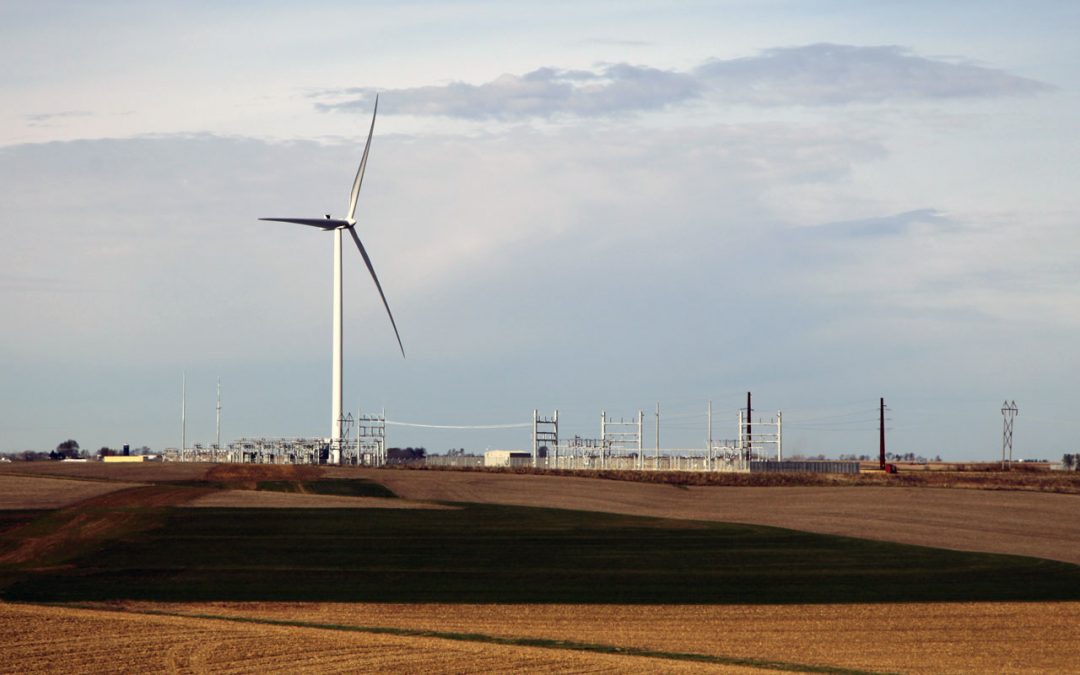
by Michael Vickerman | Mar 29, 2018 | Renewables, Solar, Utilities, Wind
A commentary by Tyler Huebner and Michael Vickerman
March 28, 2018
Kohler Co., a signature Wisconsin manufacturer, is set to join the dozens of U.S. corporations buying renewable electricity to displace fossil fuel generation on the electrical grid. But the source of this clean energy is nowhere near the company’s headquarters in Kohler. The wind farm that will sell this electricity to Kohler is instead located in east central Kansas, nearly 800 miles away.
A leading manufacturer of kitchen and bath products worldwide, Kohler recently entered into a 15-year contract with Enel Green Power North America to purchase electricity generated from a 300-megawatt (MW) wind power plant now under construction. Kohler’s share of Enel’s Diamond Vista wind farm is 100 MW, which will produce enough zero-emission electricity to equal the consumption of nearly 40,000 typical households.
Like many other corporate wind purchases, however, the electricity bought by Kohler will not directly supply its own operations. Instead, Kohler will resell the wind generation it buys to the wholesale electric market serving the Southern Plains states.
At the same time, Kohler will retain the renewable energy credits (RECs) associated with the output. These credits will be used to offset the greenhouse gas emissions from the electricity actually used to power all of the company’s U.S. and Canadian operations, including its flagship manufacturing facility in Kohler, Wisconsin, as well as its nearby golf and resort properties. This action will reduce Kohler’s global carbon footprint by 26%.
This is by far the largest renewable energy purchase undertaken by a Wisconsin corporation, befitting an industry leader that has embraced a goal to become net carbon neutral by 2035. With more than 50 manufacturing locations worldwide, Kohler is on the lookout for innovative pathways that can achieve substantial greenhouse gas emissions with minimal impact on its bottom line.
Corporations Looking for Renewable Energy At-Scale
The economies of scale achieved by large wind projects like Diamond Vista is quite appealing to Kohler and other corporate offtakers of renewable energy. In another example of this trend, the global beer giant Anheuser-Busch committed in fall 2017 to purchase RECs from the Enel-owned Thunder Ranch wind power project under construction in Oklahoma. That transaction will enable Anheuser-Busch to reduce emissions from its electricity purchases in the United States by 50% (and garnered this logo on each bottle and can of Budweiser now sold in the U.S.)

In addition to its environmental benefits, Kohler’s purchase will set in motion a significant economic jolt that will last throughout Diamond Vista’s operating life. Unfortunately, these economic benefits will be reaped entirely by the host communities in rural Kansas, bypassing Wisconsin altogether.
Wisconsin Renewable Projects Coming Online
The recently commissioned Quilt Block wind farm in southwest Wisconsin exemplifies the economic development potential represented by renewable generation. The largest power plant energized in Wisconsin last year, this 98 MW installation will, over its lifetime, direct millions of dollars in landowner payments and tax revenues into the coffers of both Lafayette County and the host township. At the same time, Quilt Block will supply La Crosse-based Dairyland Power Cooperative and its members with clean, affordable electricity under a long-term contract.
As it happens, the developer of Quilt Block, Houston-based EDP Renewables, would like to develop additional projects near where this project was just completed. In addition, numerous solar developers are eyeing opportunities to build large-scale solar in Wisconsin. These projects could, in theory, supply local corporate or institutional customers with the renewable power they are seeking, while strengthening the local economy where the projects are built. That certainly has all the earmarks of a win-win proposition for Wisconsin.
Two Models for Wisconsin’s Success
There are two models in early stages that could facilitate these win-wins for Wisconsin companies and local economies.
The first option is a “Corporate Renewable Energy Service,” which electric utilities can put in place to connect larger customers with low-cost renewable power generated from solar arrays or wind farms located in Wisconsin. These three-party arrangements connect the corporation (or local government), the utility, and a specific renewable energy project. The benefit to the company is a relatively seamless, and perhaps cost-neutral, arrangement that flows the energy production through on their existing utility bill.
We supported Madison Gas & Electric as they pursued such a service in 2017. However, they remain the only utility explicitly offering this service in Wisconsin. We need other utilities to design and offer this type of service to enable Wisconsin-based companies to connect to home-grown renewable projects.
The second model was trail-blazed by Organic Valley last year. OV, a farmer-owned food cooperative headquartered in La Farge, Wisconsin, recently agreed to purchase RECs from new solar arrays supplying power to a consortium of municipal electric utilities in southwest Wisconsin and Minnesota.
This amounts once again to a three-party arrangement. Two separate agreements are needed: the utility and the renewable energy project owner reaches an agreement on energy price, while the corporation desiring renewable energy strikes an agreement with the wind/solar project developer on the price for the separate renewable energy credits. One difference is that the utility bill for the corporation is unchanged, while they have a new expense for the purchase of the RECs.
Compared with Kohler’s 100 MW purchase, the 12 MW of renewable generation leveraged by the Organic Valley purchase is modest, but it could serve as a model for other state-based companies and local governments to embrace.
Both of these models have merits. For a company like Kohler seeking to offset its entire North American footprint of electricity consumption, a REC model makes tremendous sense. They were able to facilitate one REC deal that substantially accomplishes their goal as opposed to working through many utilities that serve their operations throughout the continent. (It’s also important to note that Kohler plans to continue its industry-leading energy efficiency efforts and explore on-site renewable generation as well.)
What’s clear is that Kohler and Organic Valley are just the beginning for Wisconsin companies seeking large amounts of renewable energy.
Wisconsin’s whole economy will benefit most if we can maximize the number of in-state projects to serve these Wisconsin-based companies. Now is the time for our electric utilities and large corporations to work together to facilitate in-state success stories for achieving corporate sustainability goals while building Wisconsin’s local economies.







